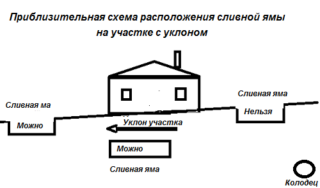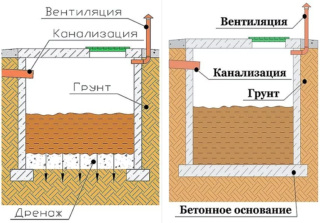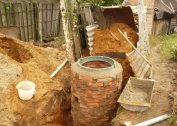If there is no possibility in a private house to connect to the central sewerage main line, its owners are allowed to build a local sewage treatment plant. An inexpensive option is to arrange a cesspool with your own hands. It is important to design the structure in accordance with all the rules so as not to violate sanitary and construction norms and rules and not fall under administrative responsibility.
Sanitary and building codes for cage design
In accordance with SanPiN 42-128-4690-88, it is allowed to install a filtering cell in cottages and in temporary use buildings. On the personal territory of the cottage, it is possible to build only a sealed device.
In the first embodiment, the installation of an impermeable bottom for a pit up to three cubic meters is optional. The principle of the abduction mechanism is as follows:
- Through a drain located in the upper part of the chamber, sewage enters the well.
- Settling of solid fractions takes place.
- The liquid enters the earth through the openings in the sides and the filter bed equipped at the bottom.
To clean the slop mass at the bottom of the cesspool make a two-layer pillow. Sand mixture and gravel or gravel of medium and large fractions are poured. The thickness of the sand layer is up to 20-30 cm, gravel is up to 50 cm. The use of fine-grained gravel is non-functional: it compacts over time, and it is more difficult for sewage to pass through a pillow.
According to the regulations, the sewage filtration tank needs to be systematically released from the sediment accumulating at the bottom. Cleaning is carried out at least once every two months. It is forbidden to use the structure without a bottom when the volume of the drain fluid exceeds 24 cubic meters.
If plumbing is installed in the house and more than two people live at the same time, according to sanitary standards and SNIPs, the drain pit must be sealed. The same applies to cottages where they live on an ongoing basis. Insufficiently treated effluents can enter subsoil sources supplying a well or well. Drinking water from it carries a health risk. Also, sealed sewer devices protect the fertile soil layer from the penetration of household residues.
The principle of operation of a sealed well or pit is as follows: waste water flows into a storage tank through a drain pipe. After reaching the acceptable level, they call the scavengers.
Special equipment is used for cleaning, independent pumping of sewage effluents, as well as disinfection of a well with bleach, is not allowed.
Among the main requirements for the arrangement - compliance with the conditions of the installation depth. To prevent flooding of the well, it is necessary to calculate the dimensions of the pit so that the groundwater level is not higher than 90 cm from the bottom of the chamber. The greatest depth for sealed containers is 3 m, which is due to the peculiarities of sewage equipment.
Another important requirement - the bulk of the waste should be located below the level of freezing of the earth. And the maximum level of filling the tank should be 35 cm below the cover. The cesspool, regardless of design, should be equipped with a ventilation pipe with a cross section of 100 mm or more. Ventilation output above ground level of at least 70 cm.
Material requirements
For the arrangement of cesspools are most often used:
- Concrete and reinforced concrete rings. Finished perforated products are used to install a well with a tap through the walls and bottom.The connection is carried out using factory locks or a sealing compound. At the top, installation of a sealed cover and ventilation outlet are required.
- Brick. The masonry is performed on the solution with the creation of filter slots for draining the liquid into the ground.
- Plastic. The installation of a polymer tank is the optimal solution for a sealed cell. The walls of the products consist of several layers, which reduces the likelihood of freezing and cracking. Their service life is up to half a century.
The factory-made drives come with a sealed cover, internal steps for servicing, venting in the upper part, and a pipe connection for connecting the pipeline. Capacities are issued with smooth walls that facilitates cleaning.
Location selection
 Regulatory documents limit the location of the cesspool and septic tank in the area. The treatment plant is located at a distance from neighboring structures and garden plantings:
Regulatory documents limit the location of the cesspool and septic tank in the area. The treatment plant is located at a distance from neighboring structures and garden plantings:
- At least 5 m - from the wall or foundation of a residential building. The maximum distance from the house to the cesspool is 12 m. With greater distance, there is a risk of problems with the outflow of liquid in the pipeline.
- A meter from a bathhouse, a barn or other outbuildings.
- The distance from the cesspool to the site border is 2–4 m. This concerns the fence of neighbors. From the roadside adjacent to the site, the indent is 5 m.
- The minimum distance to garden plants, flower beds - from 4 m.
When planning a cesspool, a study of the soil is always carried out in order to determine its composition. It takes into account how much moisture it can absorb. In addition, special maps are used to determine in which direction groundwater flows. Installation is carried out in a place that is below the location of the water point.
The distance from the well to the cesspool is determined individually, and depends on the composition of the land and the direction of movement of the subsoil sources.
 If the flows flow in the direction of the receiving tank, then the drive is located at 10-15 m. In the reverse movement (from the sewer to the well or other water intake point), the distance is 40-50 m.
If the flows flow in the direction of the receiving tank, then the drive is located at 10-15 m. In the reverse movement (from the sewer to the well or other water intake point), the distance is 40-50 m.
Sanitary standards regulate not only the distance from a water well or well to a cesspool. It is necessary to take into account the location of the water pipes. The distance from the pit to them depends on the material of the pipeline:
- more than five meters - from the asbestos-cement highway;
- more than one and a half meters - from a pig-iron pipeline;
- more than one and a half meters - from plumbing made of plastic.
If the building is located near a school or kindergarten, the distance from the storage capacity to the border of the educational institution is at least 20 meters. If a pond is located nearby, then the cesspool is equipped 30 meters from the coast.
When calculating the distance from the cesspool to the neighbors, the wind direction is also taken into account. It is necessary to arrange the treatment plant so that sewage odors do not reach residential buildings.
To resolve issues that may arise during the construction of the pit, the owner of a private cottage should contact the local administration.
Planning and obtaining permits
The first thing to do is plan the location of the cesspool device:
- A plot of the plot is drawn on a paper sheet.
- With the greatest possible accuracy, the location of the building, outbuildings and water intake points is indicated, with the determination of the distances between them.
- The position of the water main is determined.
- The distance between the buildings and the boundaries of the territory is indicated.
- The position of garden paths, small architectural objects, trees and shrubs is schematically indicated.
- The direction of groundwater movement is determined.
- The soil composition on the site is recognized.
It is advisable to create a large-scale plan at the rate of 1: 100.
Failure to comply with the requirements for the installation of cesspools and other treatment facilities causes pollution of drinking water sources and soil infection. The construction of a cesspool is coordinated with the bodies of sanitary supervision and water utilities. This must be completed in order to obtain a building permit. The cost of documents will be about 200 rubles.
If there is no permit documentation for the installation of a sewer well, there is a risk of fines ranging from 500 rubles to several thousand.
The correct position of the cesspool is important due to the fact that sulfur dioxide and methane are released during sewage bioprocessing, which pose a risk to health and the environment.
If there are restrictions on the area of the site, you should contact the local authorities of the water utility and Rospotrebnadzor. After analyzing the situation, it is possible to reduce the normative distances.






